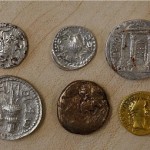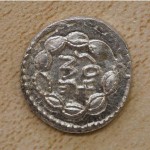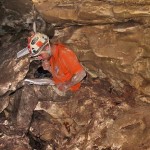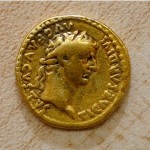Archaeologists from the the Hebrew University of Jerusalem and Bar-Ilan University researching and mapping an extensive cave system in the Judean hills have found a cache of 120 gold, silver and copper coins dating to the period of the Bar-Kokhba Revolt, between 132 to 135 AD.
The some 120 coins were discovered within a cave that has a “hidden wing,” the slippery and dangerous approach to which is possible only via a narrow opening discovered many years ago by Dr. Gideon Mann, a physician who is one of the early cave explorers in modern Israel. The opening led to a small chamber which in turn opens into a hall that served as a hiding place for the Jewish fighters of Bar-Kokhba.
Most of the discovered coins are in excellent condition and were overstruck as rebels’ coins on top of Roman coins. The new imprints show Jewish images and words (for example: the facade of the Temple in Jerusalem and the slogan “for the freedom of Jerusalem”). Other coins that were found, of gold, silver and bronze, are original Roman coins of the period minted elsewhere in the Roman Empire or in the Land of Israel.
That’s pretty damn industrious for rebels to re-strike minted coins with their slogans and symbols. They were quite successful rebels, in fact, as they actually established a self-governing Jewish state for a couple of years over various parts of Judea, with Simon Bar Kokhba as the ruler. The silver and copper coins were re-struck during that period. The gold coins still retain their original Roman minting.
This many high quality Bar-Kokhba period coins have never been officially found before. Looters have kept a steady stream of them on the black market so who knows what other hoards have been uncovered in an unofficial capacity, but this is the largest cache ever recorded.
It’s also significant in its location. The cave is near the ancient fortress of Betar, the site of the Bar-Kokhba revolt’s last stand against the Roman legions after they were chased out of Jerusalem. The refugees who fled to the cave with their most valued possessions were preparing for the worst, but doubtless hoping they’d be able to come back and reclaim their treasures.
They weren’t, obviously, and in the end, over a half a million Jews were killed, plus more sold in to slavery. In retaliation for the revolt and to prevent any future attempts against his imperial authority, Hadrian exiled all Jews from Jerusalem, outlawed the Torah, built statues of himself and Jupiter on the site of the Temple, and literally wiped the name of Judea off the map, renaming the region Syria Palaestina after the Philistines of Goliath fame.



